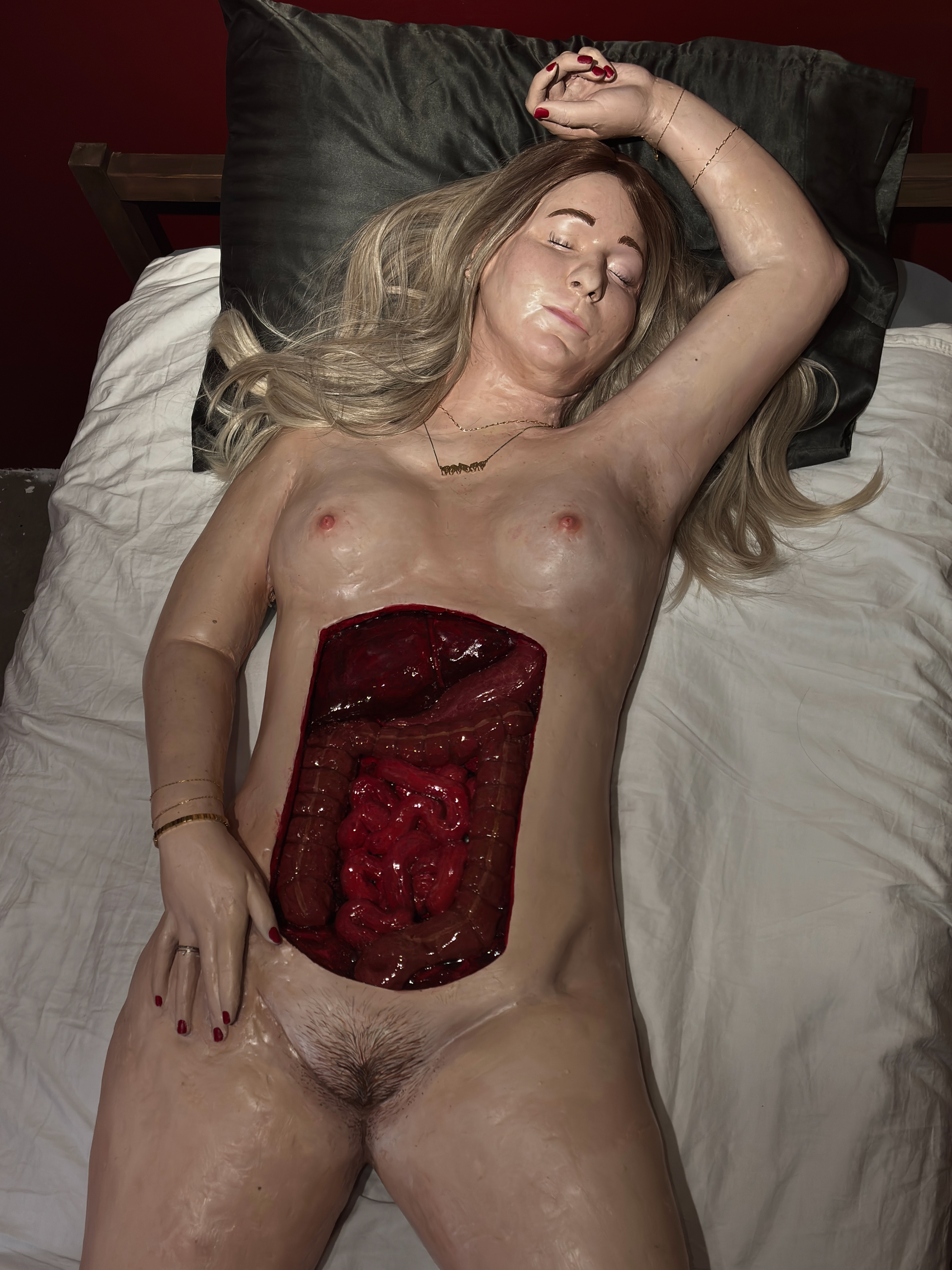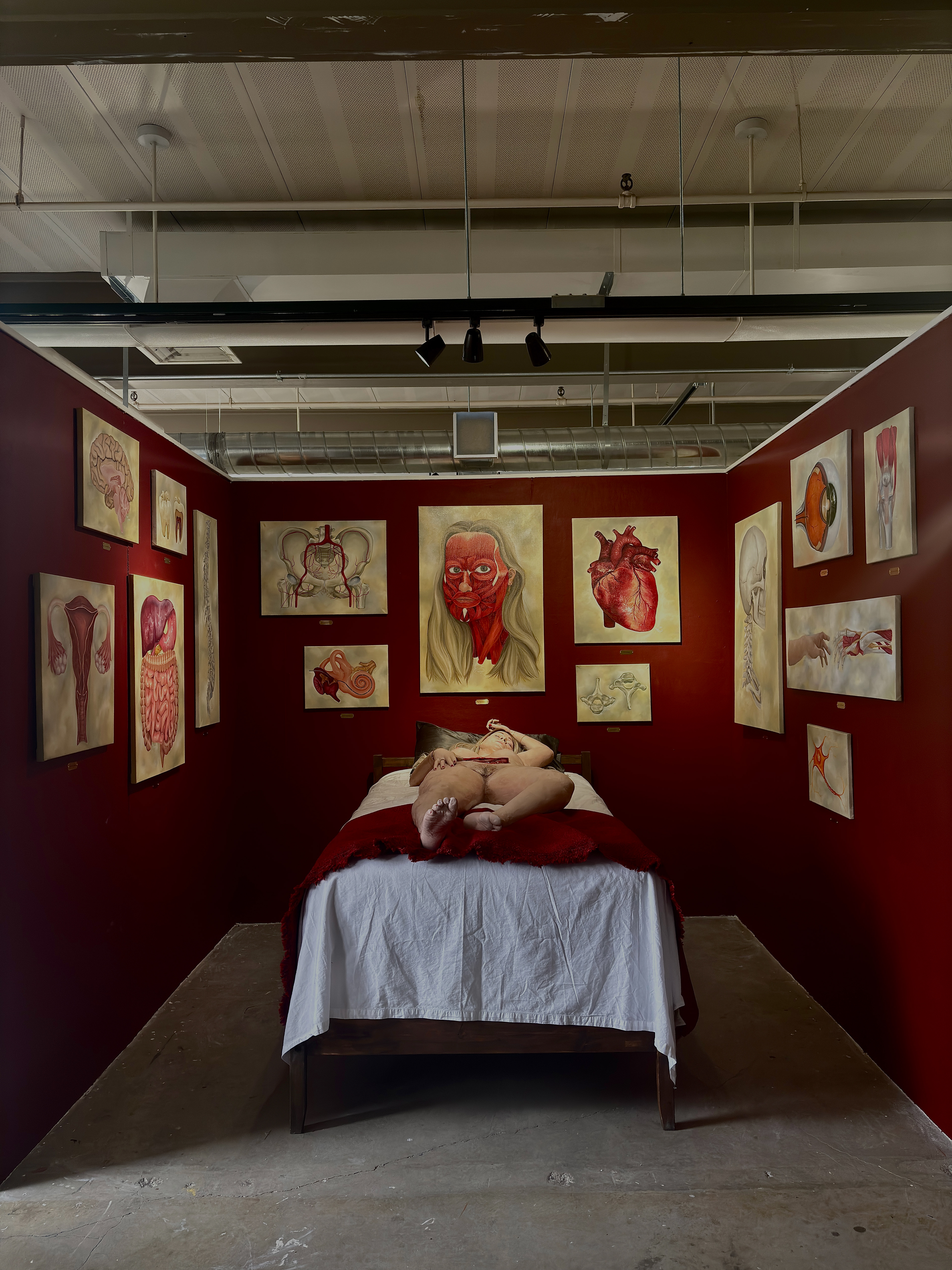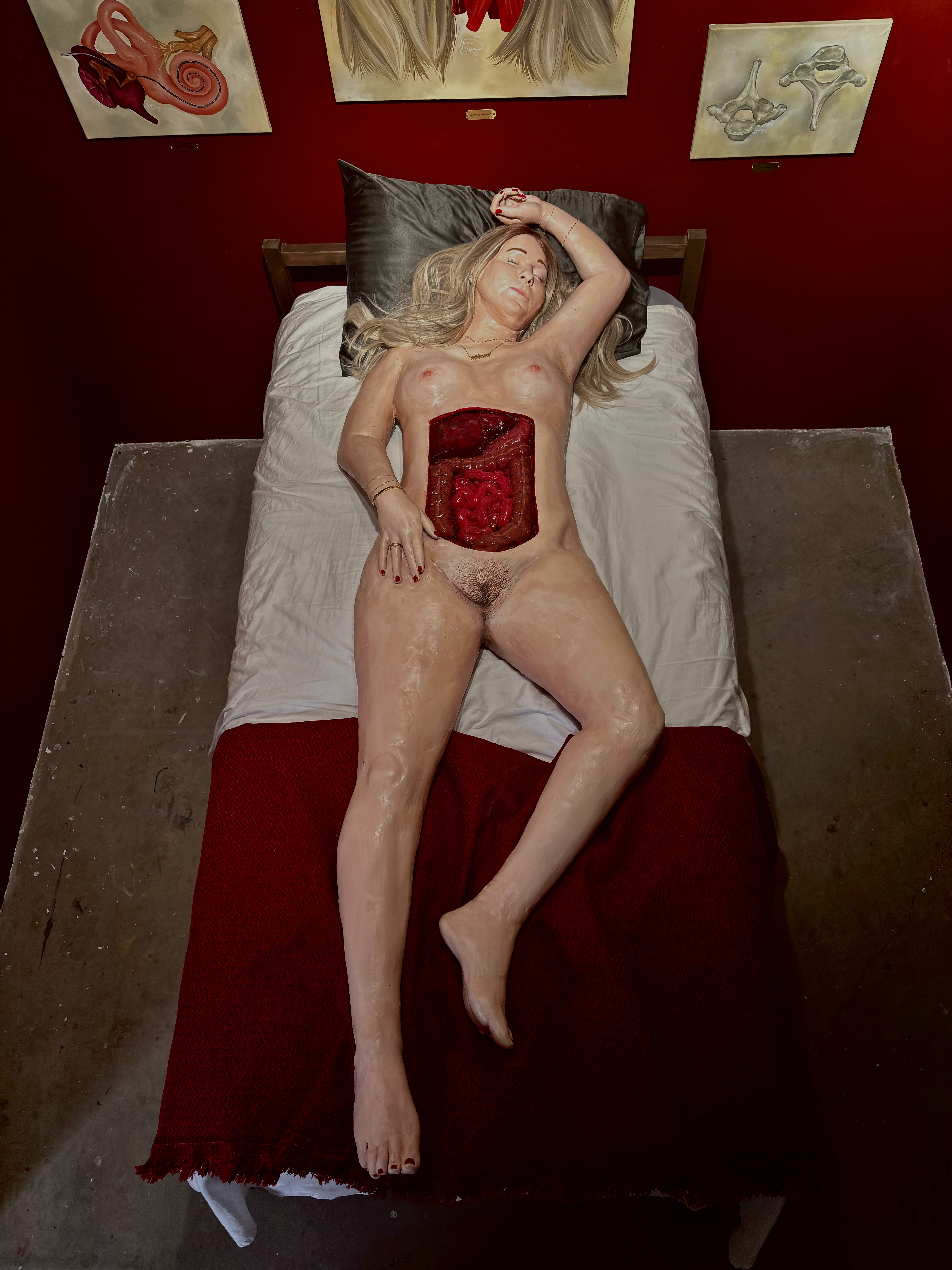"Dissecting Beauty" is a collection of work for my senior Integrative Project, a year-long course of self-guided research and creative practice, and was exhibited at the "Perspectives(s)" Integrative Project exhibition at Stamps School of Art and Design from April 21st to May 3rd, 2025.
Anatomical intricacy can be something separate from the physical trauma that can be associated when confronted with the internal body. The structures beneath our skin create and dismantle who we are as individuals.
Throughout history to our current day, women have been subject to unjust standards that infect our physical and emotional wellbeing. As a result of a patriarchal society, women’s healthcare is still decades behind men’s. Similarly to the lives of thousands of women, I’ve only ever viewed my body with disgust, constraining myself to the harsh realities of what it means to be a woman. Through the lens of body dysmorphia, I investigated my own perception of beauty in a life-sized self portrait in the vein of Clemente Susini’s Anatomical Venus. The art of anatomy embraces the extraordinary beauty of how those structures inform our identities.
Evidently, my work draws attention to the necessity of medical illustration in visualizing the unknown and accentuates the intertwined relationship between science and art, proposing that one cannot exist without the other. I ask viewers to dissect the work in front of you, to reevaluate your own perception of beauty, and to discover the anatomy of your identity.
Individual descriptions of the work are down below, as well as collection images of the final exhibition and each piece.
Fig. 9 "Intricacy"
This was the first painting of the series that inspired the rest of the work. While it doesn’t have a direct correlation with misogynistic standards, the heart represents my own personal connection to medical illustration as it was the first organ I had ever painted in early high school. This painting was a recreation of that painting, which was my first oil painting, and so this piece shows my own self-growth as an artist while retaining roots to when I discovered I wanted to become a medical illustrator.
Fig. 4 "Hourglass Syndrome"
This piece features the abdominal organs and alludes to the effects on the body from sucking in to appear thinner, or what’s known as Hourglass Syndrome. This stems from an extremely toxic and dangerous standard that women should be thin and petite, and heavily shown on social media and TV. This standard inspired the evolution of this dangerous syndrome that permanently alters the muscle of the abdomen and displaces organs as a result of women trying to look as thin as they can.
Fig. 3 "Bite Your Tongue"
Women are often told to remain silent and not express strong opinions. This piece explores the phrase “bite your tongue” that has been around for centuries, rooting women’s inequality into our language. I depicted the anatomy of a tooth to connect to the lack of voiced opinions we can comfortably share, as well as the standard that women should always smile and be polite, no matter the situation. These standards degrade the experiences of women and my painting showcases that women should share their every opinion and break the silence.
Fig. 1 "1973 to 2022"
Roe v Wade. A strong standing federal law that gave women the right to bodily autonomy, has been torn down for the beliefs of weak, biased, and misogynistic men who lack an understanding for women’s bodies. This work explores the effects of our self-serving government of uneducated males. Throughout history and now, women’s healthcare has been drastically behind compared to that of men’s. As a result, women do not get equal access to healthcare and even have the highest maternal mortality of first world countries. Further effects are taking place around our country, making women and young girls more unsafe by the day. If this does not anger you, my work is not for you.
Fig. 8 "Am I Pretty Now?"
My self portrait shows the muscular layer that lies underneath the skin and explores the various standards that we hold on ourselves. Women constantly critique ourselves as a result of societal expectations for what is beautiful and what isn’t. This piece is incredibly important to me because it is the first self portrait that I felt embodied who I was as an artist and represented something internal, not just my physical appearance. Women are constantly antagonized for whether or not they wear makeup and constant comments on our facial appearance, of which never happens to men.
Fig. 6 "Anatomy of the Thigh Gap"
The visualization of the pelvic bones and veins suggest an exploration of the harsh beauty standard that women should have a thigh gap. The view that women should always be thin enough that their thighs do not touch is unhealthy, unjust, and a toxic standard that affects women all around the world, especially in western societies. This painting is also incredibly important to the rest of the work because the pelvic bone is one bone in the body that is significantly different than that of men’s for natural anatomical reasons, mainly childbirth. There are reasons that women and men have different structures; however, they are not the reasons that women should be treated differently than men.
Fig. 13 "Run Like a Girl"
This work explores the anatomy of the knee, a joint that is weak in my own body as a result of Ehler Danlos Syndrome. Women will forever remember the phrase “run like a girl” and its interpretation of women having to run for their lives as we often have to fear men on a daily basis and worry for our safety. At least 81% of women have been harassed by men in the United States, and 3 in 4 women have experienced sexual violence at least once in their life. To run like a girl is to have feared for your life and have to trust no one, a life we shouldn't have to live.
Fig. 5 "Like a Lady"
This work features the side profile of the natural curvature of the spine in order to explore the connections between the spine and societal standards for women’s behavior. Women are constantly told to “act like a lady” or “sit like a lady”, enabling misogynistic standards that women have to behave a certain way. This standard requests that women always hold a perfect posture and appear submissive to men. The spine also alludes to standing up tall, as a way for me to reach women and allow my work to encourage them to tear down these standards and stand up for themselves.
Fig. 11 "Jaw Dropping"
This work features the side profile of a skull to represent the “ideal side profile” that cannot exist. Many people, men and women alike, attempt to make their jaw look more chiseled and have no “double chin”, without regard for differences in anatomy and genetics that might change the way each individual looks. The ideal jaw is so chiseled that it might as well just be bone, hence the anatomical side profile painting. Furthermore, this painting plays on the phrase “jaw dropping” which we say when someone or something is beyond beautiful.
Fig. 12 "Beauty in the Eye of the Beholder"
This piece explores perspectives of beauty through examining how vision plays a role in societal perspectives. Women are “seen” as less than men, which diminishes our perspectives, perceptions, and experiences with the world. Furthermore, I chose a green iris so that it matched my own eyes so that it resembles how I look at my own experiences of being a woman in this world.
Fig. 15 "Sensitivity"
This interpretive painting of a nerve cell represents the continuation of women being told that we are overly sensitive. Throughout history and still now, men paint women to be overly sensitive and reinforces the stereotype that whenever a woman is sensitive they are on their period, which belittles and diminishes us.Women are not sensitive, we have empathy, something that men should attempt to feel. This also represents to me that we are more than just our bodies and hormones. There is no excuse for treating women with inequality.
Fig. 10 "Ethereal"
The visualization of a single vertebrate shows a delicate bone in the body that builds upon the posture and structure of the spine, while protecting the spinal cord and many delicate nerves. This piece explores the standard of enforcing a good posture and appearance that women should always appear at their “best” and to “act like a lady”. Women are also viewed as dainty and delicate, easy to break, rather than individuals of strength and power, which influenced the title for the work.
Fig. 2 "Beauty and Brains"
This work references a saying that women are “beauty” or “brains, but never both, suggesting that we are objects of desire that are not capable of intelligence. To this I saw look at the work around you and see that I am a confident woman of scientific and creative knowledge. This standard affects the self-confidence of many women, leading us to believe that we won’t be as smart as men, which is incredibly inaccurate and harmful.
Fig. 14 "Internal Reaching"
The feature of delicate hands alludes to standards of perfection and femininity, the belief that women should be elegant, docile, and proper. While there is nothing wrong with a woman being any of these things, women who are not these should not be seen as less than a woman. There is a longstanding stereotype that women should look and act a certain way in public as if women are not people. We are not animals to be trained and told what to do, but rather individuals that should be treated with nothing less than equal respect.
Fig. 7 "Listen Closely"
This painting focused on the inner ear, specifically the vestibulocochlear nerve and the insertion of an electrode of a Cochlear Implant, a device that I have to assist my lifelong deafness. I invite viewers to interpret this piece as a resemblance to women being told to listen, and yet never being listened to. The inclusion of the electrode is a personal connection that I wanted to include as I see my identity in every one of these paintings.











